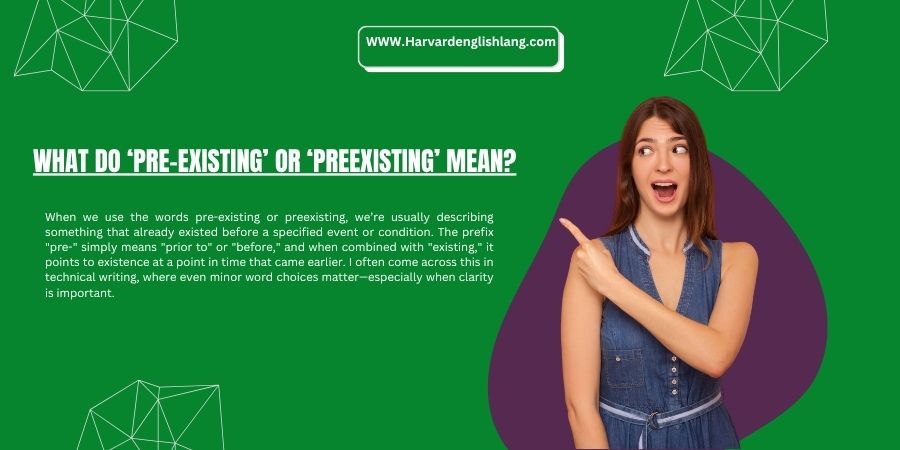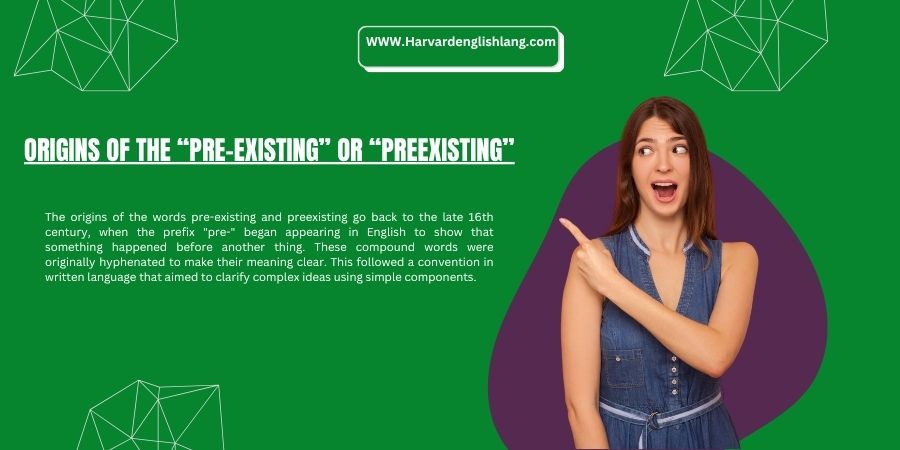As someone who’s spent years in writing, I’ve often seen even experienced writers feel puzzled over small details—especially when it comes to the choice between words like pre-existing and preexisting.
This isn’t just a matter of spelling; it’s about understanding the difference and making the correct decision based on context. In this article, I’ll walk you through the practical usage of both terms and share personal guidelines that have helped me and others make clearer, more confident choices.
Whether you’re drafting formal content or casual pieces, understanding this distinction makes your work stand out. So let’s dive into the nuances and clear up the confusion once and for all.
Why is there Confusion?
As someone who’s worked with language for years, I’ve often found it challenging to decide whether to use pre-existing or preexisting, especially when facing mixed advice from different style guides and dictionaries.
The confusion comes from how compound words are formed in English. Some compounds are open, like ice cream, where there’s a space between the words.
Others are hyphenated, like mother-in-law, while many have become closed, like notebook. These forms can shift over time, and what was traditionally accepted may no longer be considered correct. It’s no surprise that even skilled writers get stuck figuring out the right version.
What makes things harder is how language evolves, and how the preferences of editors or publishers vary.
The transition from hyphenated to closed forms usually happens as words become more commonly used, but it doesn’t always follow a straightforward or consistent pattern.
Many now lean toward simplicity, and that’s why preexisting is gaining popularity. Still, depending on where you look, one form may seem more “correct” than the other. That varying guidance can be frustrating, but it also shows how flexible and living the English language truly is.
You Might Also like: Master ‘Which of the Following’ with These Simple Tips!
What do ‘Pre-Existing’ or ‘Preexisting’ Mean?

When we use the words pre-existing or preexisting, we’re usually describing something that already existed before a specified event or condition.
The prefix “pre-” simply means “prior to” or “before,” and when combined with “existing,” it points to existence at a point in time that came earlier. I often come across this in technical writing, where even minor word choices matter—especially when clarity is important.
For example, in software development, a bug or defect that was found in a program before the latest update or release is often referred to as a preexisting issue.
Similarly, in real estate, a structure that was built before current regulations, standards, or codes were in place would be called pre-existing.
These terms also refer to things that are present, not new, and are often discussed in relation to what changed after a certain moment. Whether it’s development, regulations, or any other domain, understanding the same term across fields gives you control over language and communication.
“Pre-Existing” or “Preexisting”: Which One Should Be Used?
Style Guides and Consistency:
Different style guides have different preferences, which can make choosing between pre-existing and preexisting a bit tricky.
For example, the Chicago Manual of Style often leans toward hyphenated compounds like pre-existing.
While APA or AP style may accept preexisting if the usage flows naturally. The key is consistency—whichever form you choose, stick with it throughout your writing. I’ve found that in professional settings, following the house style or publication standard avoids unnecessary edits or confusion.
Readability and Clarity:
From my own experience as a writer and editor, I know that readability matters.
Sometimes, a hyphen adds helpful visual separation, making pre-existing easier to read, especially for complex texts or technical content.
On the other hand, preexisting can feel smoother and more modern in casual or internal documents. The choice should support clarity, not clutter it. If a reader stumbles or hesitates, it defeats the purpose of communication.
Audience and Context:
Knowing your audience is just as important as grammar.
In formal documents, such as legal, academic, or medical writing, pre-existing might be more expected due to its traditional structure.
But in tech, marketing, or digital content, preexisting feels lighter and more intuitive. I usually consider the context of the message:
Is it strict and rule-bound or flexible and conversational? That helps guide the choice naturally.
You Might Also like: Coach vs Couch: Definitions, Differences, and Examples
Origins of the “Pre-Existing” or “Preexisting”

The origins of the words pre-existing and preexisting go back to the late 16th century, when the prefix “pre-” began appearing in English to show that something happened before another thing.
These compound words were originally hyphenated to make their meaning clear. This followed a convention in written language that aimed to clarify complex ideas using simple components.
I’ve noticed, while reviewing older texts, that the communication was much more formal and every word had to be placed carefully to avoid confusion.
By the mid-20th century, especially in the medical and insurance industry, the term became common to describe a health condition or issue that was already present beforehand—before someone applied for coverage.
It was even documented officially in 1942, showing how real-world usage shaped the term. Over the years, the evolution of the word moved toward closed forms, reflecting broader trends in language that favor simplicity, efficiency, and smooth expression.
In my experience, this shift has made writing easier and more fluid while still respecting the formality of the past.
Examples in Context
Pre-Existing:
- Medical: The insurance policy does not cover any pre-existing conditions diagnosed before enrollment.
- Legal: The new law cannot override pre-existing agreements made under prior legislation.
- Real Estate: Renovations must comply with updated codes unless the building is a pre-existing structure.
- Technology: The software update fixed a pre-existing bug that caused system crashes.
- Business: They had a pre-existing contract with another supplier before the merger.
Preexisting:
- Technology: The patch addressed a preexisting vulnerability in the app’s security framework.
- Science: The researchers built their theory on preexisting data collected over the past decade.
- Business: She joined the company with a preexisting understanding of the market trends.
- Education: Students with preexisting knowledge of coding advanced more quickly in the course.
- Health: They had to disclose any preexisting medical conditions before signing up for the trial.
Synonyms for “Pre-Existing” or “Preexisting”
Synonyms for “Pre-Existing
- Prior
- Previous
- Earlier
- Already existing
- Established
- Former
- Antecedent
- Preceding
- In place
- Ongoing (if continuing from before)
Synonyms for “Preexisting”
- Existing beforehand
- Already present
- Previously existing
- Prior
- Earlier
- Established
- Preceding
- Ongoing (if it started earlier and continues)
- Priorly formed
- Initial
Conclusion
From my own experience as a writer and editor, the debate between preexisting and pre-existing often comes down to preferences shaped by style guides and the kind of writing you’re doing.
In formal documents, pre-existing is often favored and traditionally accepted because of its clarity, especially when communicating complex ideas.
On the other hand, in modern usage, the simplicity of the closed form, preexisting, is becoming more recognized and preferred for its readability and consistency with other forms.
The choices may seem small, but they reflect deeper stylistic decisions that can shape how your text is understood.
The key is understanding the contexts, knowing the guidelines, and making appropriate adjustments that match your specific needs.
When I started out, I often checked multiple style guides to ensure adherence and professionalism in each project. As I became more confident, I learned to assess which version fit the meanings, origins, and purpose of the sentence better.
Whether you’re following a traditionally hyphenated approach or going for the modern closed version, staying consistent helps maintain coherence and effective communication. Ultimately, writers should rely on what feels most relevant and natural to the contexts they’re writing in—and stay true to their own thoughtful endeavors.

A communication coach with a background in public speaking and business English. He helps professionals refine their English for workplace success.
